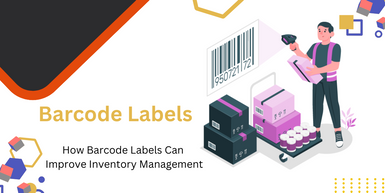Posted by Label Warehouse on 9th Nov 2023
How Barcode Labels Improve Inventory Management
Effective inventory management is a cornerstone of success in the business world. It's the art and science of overseeing, storing, and tracking a company's goods to ensure they are available when needed while keeping carrying costs low. In a world driven by customer demands and supply chain complexities, businesses cannot afford to overlook the significance of sound inventory management practices. It enables companies to meet customer demands efficiently, reduce the risk of overstocking or understocking, minimise carrying costs, and maintain a competitive edge in the market. By optimising the balance between demand and supply, inventory management plays a crucial role in enhancing profitability, customer satisfaction, and the overall operational efficiency of businesses across various industries.
One tool that has revolutionised inventory management is barcode labels. In this blog, we will explore how barcode sticker can enhance inventory management and streamline your business operations.
Overview of Barcode Labels in Inventory Management
Barocde Labels are a fundamental tool in modern inventory and data management. They are composed of a series of parallel lines, numbers, and sometimes other symbols, designed to be read by a barcode scanner. Each barcode label represents a unique identifier that can store a wide range of information, such as product details, pricing, and tracking data. These labels can be attached to products, packages, or documents and provide a quick and accurate means of data entry and retrieval. Barcode labels have become ubiquitous in various industries, from retail and healthcare to manufacturing and logistics, as they greatly improve efficiency, accuracy, and speed in processes such as inventory management, checkouts, and tracking of goods and assets. This technology has revolutionised the way businesses handle data, making it an indispensable tool for optimising operations and enhancing overall productivity.
Types of Barcode Labels for Inventory Management
There are several types of barcode labels, each designed for specific purposes and industries. Here are some of the most common types:
UPC (Universal Product Code)
These are widely used in the retail industry and typically consist of 12 numeric digits. UPC barcodes help retailers identify products and track sales.
EAN (European Article Number)
Similar to UPC, EAN barcodes are also used for retail, but they typically have 13 digits. They are used internationally to identify products.
Code 39
A versatile barcode type that can encode alphanumeric characters, including letters and numbers. Code 39 is used in various industries, such as healthcare, logistics, and the automotive sector.
Code 128
This barcode type can encode a large amount of data, including letters, numbers, and special characters. It is often used in shipping and packaging to track and manage inventory.
QR Code (Quick Response Code)
QR codes can store a significant amount of data, including URLs, contact information, and more. They are widely used in marketing, mobile payments, and ticketing.
Data Matrix
These 2D barcodes can store information in both horizontal and vertical directions, making them suitable for applications like small item tracking, electronics, and healthcare.
PDF417
Another 2D barcode that can store large amounts of data, including text and binary data. It is commonly used for identification cards, driver's licenses, and shipping labels.
ISBN (International Standard Book Number)
ISBN barcodes are used for books and printed materials to uniquely identify them and simplify the inventory process in libraries and bookstores.
Postal Barcodes
Various barcodes are used by postal services worldwide to sort and track mail and packages. Examples include USPS Intelligent Mail Barcode (IMB) and Royal Mail's RM4SCC.
Codabar
Often used in libraries and blood banks, Codabar encodes numbers, as well as some special characters, and is designed for specific, non-retail applications.
MaxiCode
MaxiCode is used by courier and delivery services to efficiently manage package tracking and delivery information.
Benefits of Barcode Labels for Inventory Management
Accuracy
Barcode labels are designed to be unique to each product or item. When scanned, they provide an exact and error-free representation of the item's identity. This eliminates the potential for mistakes that often occur with manual data entry, such as typographical errors or misinterpretation of handwritten information.
Efficiency
Scanning a barcode is much faster than manually recording product details. This speed can have a substantial impact on various inventory management processes, including receiving, order fulfilment, and cycle counting. Efficiency gains can lead to shorter lead times and reduced labour costs.
Real-time Updates
Barcode scanning technology allows for immediate updates to your inventory management system. As items are scanned in or out of your inventory, the system reflects these changes in real-time. This ensures that you always have an accurate and up-to-the-minute view of your inventory levels, reducing the chances of stockouts or overstocking.
Error Reduction
Barcode labels are unique, reducing the likelihood of confusion or misidentification. This is particularly important in scenarios where products are visually similar but have subtle differences. Barcode labels minimise the risk of shipping the wrong item or misplacing inventory within a warehouse.
Enhanced Visibility
Barcode labels enable businesses to have greater visibility into their inventory. Tracking the movement and location of items becomes much easier, which is essential for efficient supply chain management and optimising warehouse operations.
Data Analysis
The data collected from barcode scanning provides valuable information that can be analysed to make informed decisions. You can identify sales trends, determine which products are slow-moving, and optimise your inventory based on real-time data, ultimately improving your bottom line.
Inventory Tracking
For industries where tracking specific item details is crucial, such as healthcare or food, barcode labels allow for precise tracking of items with characteristics like expiration dates, batch numbers, and serial numbers.
Streamlined Reordering
By setting up automatic reorder points in your inventory system triggered by barcode scans, you can ensure that items are restocked promptly. This helps prevent stockouts, ensures product availability, and minimises excess inventory, which can lead to cost savings.
Cost Savings
The combined effects of increased accuracy, improved efficiency, and reduced errors result in cost savings. Labour costs are minimised, carrying costs are reduced, and losses due to stockouts and obsolete inventory are diminished.
Compatibility
Barcode systems can often be integrated with your existing inventory management software and hardware, making it easier and more cost-effective to adopt this technology.
Scalability
Whether you're a small business with limited inventory or a large enterprise with a vast stock, barcode systems are scalable and adaptable to your specific needs, allowing you to use them as your business expands.
Customer Satisfaction
Accurate inventory levels mean fewer backorders and less order fulfilment delays, leading to higher customer satisfaction and loyalty.
Compliance
In regulated industries, such as pharmaceuticals or food production, barcode labels can help ensure compliance with traceability, safety, and reporting requirements, which are crucial for legal and quality control purposes.
Enhanced Security
Barcode labels can be used to track high-value assets or restricted items, reducing the risk of theft, unauthorised access, or tampering.
Reduced Paperwork
Barcode labels reduce the need for extensive paperwork and manual record-keeping, which streamlines administrative tasks and helps businesses become more environmentally responsible by cutting down on paper usage.
How to Choose the Right Barcode Labels for Your Inventory
Choosing the right barcode label for inventory management is a crucial decision to ensure efficient and accurate tracking of your products. Here are the key steps and factors to consider when making this choice:
Understand Your Requirements
Start by understanding your specific inventory management needs. What type of products or items will you be tracking? Consider the size, weight, and material of the items, as well as any unique features they may have.
Select the Barcode Type
Different barcode types are suitable for various applications. For retail, UPC or EAN barcodes may be sufficient, while industries like healthcare or logistics may require more versatile barcodes like Code 128 or Data Matrix. Choose the barcode symbology that best matches your requirements.
Label Size and Material
Determine the appropriate label size based on the items you're labelling and where the labels will be placed. Consider the environmental conditions, such as temperature, humidity, and exposure to chemicals, which can affect the label's material. For example, durable labels are needed in harsh environments, while standard paper labels are sufficient for many indoor applications.
Print Method
Decide on the printing method for your barcode labels. Options include thermal printing ( direct thermal labels or thermal transfer labels ) or laser printing. The choice depends on your budget, label material, and print volume.
Label Adhesive
The adhesive on the label should match your application. Some labels have permanent adhesives, while others are designed to be removable. Choose an adhesive that ensures the label stays in place without leaving residue when removed.
Label Colour
Barcode labels are often black on a white background for optimal contrast and readability. However, you can choose other colour combinations based on your needs, such as for colour-coding or branding.
Label Quantity
Consider the quantity of labels you need. Bulk printing can be cost-effective, but ensure you have enough labels to cover your inventory.
Label Durability
If your items are subject to rough handling, exposure to the elements, or other harsh conditions, opt for durable labels that resist wear and tear. This is crucial in industries like manufacturing and construction.
Testing and Quality Assurance
Before ordering a large batch of barcode labels, it's a good practice to test a small quantity to ensure they meet your requirements. This testing helps prevent potential issues with label quality, printing, or adhesion.
Barcode Label Software
Invest in a barcode label design and printing software that allows you to create and customise your labels. Ensure it is compatible with your hardware and integrates with your inventory management system.
Compliance
Be aware of any industry or regulatory standards that may dictate the type of barcode label you should use. Compliance with these standards is essential, particularly in sectors like healthcare, food, or automotive.
Scanning Equipment
Ensure that your chosen barcode labels are compatible with the scanning equipment you plan to use. Barcode scanners must be able to read and decode the symbology you select.
Supplier and Cost
Research reputable suppliers of barcode labels and compare costs. While cost is a consideration, quality and compatibility should be the primary factors in your decision.
Scalability
Consider the future growth of your business and whether the chosen barcode label solution can scale accordingly. A scalable solution will grow with your inventory management needs.
Conclusion: Enhancing Inventory Management with Barcode Labels
Barcode labels have become an indispensable tool for modern businesses looking to improve their inventory management. The use of barcode labels enhances accuracy, efficiency, and real-time tracking, ultimately leading to reduced errors and better data analysis. Investing in barcode stickers and print barcode label systems can make a significant difference in your inventory management, streamline operations, and positively impact your business's success. If you're looking to enhance your inventory management, consider implementing barcode labels as a cost-effective and efficient solution.
If you are looking for the perfect barcode labels for effective inventory management, you’ve landed on the right page. Explore the Label Warehouse website and pick out the perfect label to meet your business requirements. Shop Today!

